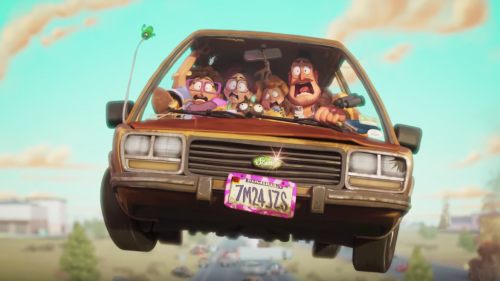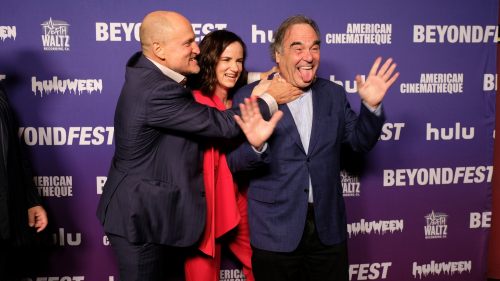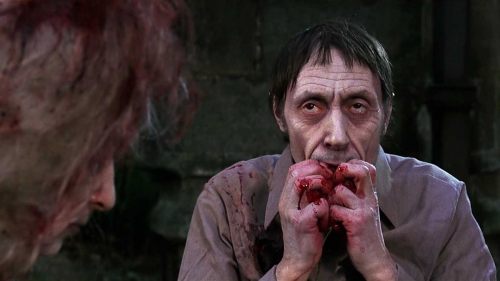Beyond Fest: David Gordon Green’s HALLOWEEN Is Messy Fun
Caution: Minor spoilers for Halloween '18 contained within.
In 1988, Halloween 4: The Return of Michael Myers was released as a means to revive/course correct a franchise that had, in terms of audience reception and box office, ostensibly died on the vine thanks to a creative miscalculation. Though it’s gone on to be (rightfully) re-evaluated as a fan favorite, 1982's Halloween III: Season of the Witch rid the series of Michael Myers, Laurie Strode, and Dr. Loomis by introducing a proposed "anthology" format, where every year we'd receive what was essentially a John Carpenter/Debra Hill-produced feature length stand-alone tale of terror. At the time, nobody wanted that, and Season of the Witch became the lowest-grossing series installment. Six years later, burgeoning journeyman director Dwight Little brought Myers home again, thanks to a break out during a facility transport, after which he hunted the daughter of a deceased Ms. Strode, while a literally burnt Loomis continued to track his white whale. Though it only grossed $3 million more than its predecessor at the box office, Halloween 4 went on to become a hit on home video, reviving a thought-dead icon.
Cut to 2015: the Halloween franchise has ostensibly fallen from grace yet again, thanks to a slew of continuity-mangling sequels and two (mostly maligned) Rob Zombie remakes/sequels. As a means of trying to patch the hull on one of horror's more prestigious ships, Ryan Turek (VP of Feature Film Development at Blumhouse Productions) shoots an email to his boss Jason Blum, inquiring about the series rights. Blum does his due diligence, green-lighting production with Rough House Pictures co-founder David Gordon Green directing and co-writing with his usual comrades Danny McBride and Jeff Fradley (all of whom just completed work on HBO's Vice Principals together). The result is a 2018 "direct sequel" to John Carpenter's original (with the widescreen horror master acting as an Executive Producer), in which Myers comes home again, thanks to a break out during a facility transport, only to hunt three generations of Strode women, while the prodigy of a deceased Dr. Loomis continues to hunt his teacher's white whale.
Structural similarities aside (which do, strangely enough, continue on in terms of plot/character development), the intent of these two sequels are distinctly similar: re-introducing Myers to a new generation of horror fans on a round number anniversary of the original movie's massacre*, while simultaneously ignoring a chunk of canon that those who've taken over the reins have deemed superfluous. Yet instead of simply omitting one motion picture, Green, McBride and Fradley have surgically removed the contradictory mythological guts established by the eight films that followed Carpenter's original body count granddaddy, boldly choosing to craft a follow-up that delivers a "forty years later" treatise on the lasting effects of trauma that these Strode woman have endured in the wake of Michael’s wrath. It's an admirably ambitious approach that pays tribute to the past, while simultaneously applying a modern quasi-feminist mindset to an antiquated horror style (the slasher).
So, does Halloween '18 work? Yes and no. The wisest decision Green, McBride and Fradley have made is returning Michael back to being The Shape (played here by both OG killer Nick Castle and James Jude Courtney). He's no longer Laurie’s brother (and barely a human being, for that matter), but rather a stalking, slaying manifestation of a greater idea. After all, that's what made Carpenter's Halloween so terrifying: the notion of an unknowable evil invading the spaces we consider to be safest (in this case: suburbia). He wasn't seeking out Laurie, she was simply there - another innocent flesh suit for this manifestation of terror to stack to the ceiling, on top of Annie, Linda, Bob and the rest of his victims on the night he came home. At the same time, Jamie Lee Curtis’ Laurie Strode became an icon of all that was good and pure in the world, so we wanted our favorite babysitter to escape from evil's clutches. Carpenter's Halloween is elemental in its storytelling, augmented by a directorial style that was informed by both old school studio workmen (such as Howard Hawks) and modern cinema tech (thanks to cinematographer Dean Cundey's use of Panaglide photography).
In Halloween '18, The Shape is just as much the flesh and blood, Shatner-masked personification of evil he was in Carpenter's, yet now he carries a new meaning for Ms. Strode. Essentially, The Shape is the unsettled emotional trauma that Laurie has carried with her for the last forty years, to the point of losing her daughter Karen (Judy Greer) to Social Services when her child was 12, and subsequently alienating her son-in-law Ray (Toby Huss, the movie's secret MVP) and granddaughter Allyson (Andi Matichak). Even if he didn't break out of a prison bus and resume his four-decades-delayed mass murder, The Shape’s mere presence in the world would've more than likely continued to haunt Laurie until she was dead in her grave, as it seems (to paraphrase one minor character's observation) that the only way to exorcise this ancient pain is to confront it head-on.
However, before we get to any of this deeper subtextual stuff, exposition must be handled. The set up for Halloween '18 is mostly delivered via two post-Serial podcasters (Jefferson Hall and Rhian Rees), looking to "re-examine" Myers' initial Haddonfield murders. It's through their journey to Smith's Grove Sanitarium that we learn just how the characters in this revamped timeline have fared in the years since their own personal knife-wielding 9/11. Dr. Loomis passed, and his case has been taken over by Dr. Sartain (Turkish character actor legend Haluk Bilginer). Myers still hasn't spoken a word in four decades, even when provoked by one of these pod people with his old mask (in the movie's rather brilliant pre-credits sequence). Meanwhile, Laurie lives in a sort of fortified compound on the outskirts of her Illinois hometown, and when the interviewers arrive, she's glad to take their $3000 bribe and then promptly tell them there's nothing left to learn by studying this monster.
Frankly, the first twenty or so minutes of Halloween '18 are pretty much perfect, introducing a plethora of thematic threads that could've been utterly fascinating, had they been properly followed through with. At this point in the lifecycle of the slasher film (a horror subgenre Halloween helped birth via its massive independent success in '78), we've already gone through an entire decade of knock-offs (the '80s), saw the subset re-jiggered (and arguably ruined) by Wes Craven's meta-textual Scream pictures, only to worm its way back into the aughts (mostly thanks to the New French Extremity) to being straight-ahead scare shows (see: the recent Hell Fest for a solid example). Using perhaps the most iconic slasher ever as a jumping-off point to discuss a woman's trauma (especially during the #MeToo era) is a brilliant re-contextualization of both the genre and Final Girl archetype, as we watch Laurie barely make it out of the house for Allyson's Honors Society dinner, only to break down crying in the middle of a restaurant, because she just saw Michael's "Shape" get onto a transport vehicle (all while clutching a pistol and deciding whether or not this is the moment she finally shoots him).
Sadly (but also understandably), Halloween '18 had to become a dead teenager picture. Once Green, McBride and Fradley's script shifts its focus away from Laurie and settles in on Allyson's high school drama (which will draw more Halloween 4 comparisons from the devoted, thanks to a gas station set piece** and Baby Strode’s douchey boyfriend) their picture becomes less interesting. In fairness, zeroing in on Allyson and her best friend Vicky (Virginia Gardner) keeps the spirit of oft-unsung franchise mastermind Debra Hill alive, as Green gets his shot at crafting The Babysitter Murders '18 (complete with a winky namedrop of Halloween producer/co-writer Hill's pseudo-autobiographical script's original title). Yet no amount of homage paid can make up for the fact that the narrative transition puts the movie slightly at odds with itself, as the meatier thematic material is dropped in favor of a more commercial/fan-minded brutality exhibition.
But oh, how bravura that brutality is. The pure slasher portion of Halloween '18 peaks with an extended sequence showcasing Myers walking through the middle of Haddonfield, aimlessly butchering its citizens while Trick-Or-Treaters obliviously seek candy from their dying neighbors. Though fans of Rick Rosenthal's Halloween II will be grinning ear-to-ear, it's another instance of Green, McBride and Fradley returning Myers to being The Shape, indiscriminately choosing his victims because evil is his true nature. As co-composer Carpenter's beefed up synth score kicks in (which he penned with his son Cody and band mate Daniel A. Davies), we can practically hear Dr. Loomis cryptically intoning "death has returned to your little town, Sheriff", as this primal presence punctures and bludgeons several human beings without reason or feeling.
Regardless of how great Halloween '18’s carnage is, the amount of runtime devoted to these random acts of violence (that eventually make their way to Allyson and her pals) water down the movie's examination of Laurie’s evolution from innocent teen to Sarah Conner-esque survivalist badass. Since we don't get to spend as many scenes exploring the pain she's endured, it renders Ms. Strode somewhat narrowly drawn and less of a character than if Green, McBride and Fradley just picked a single storytelling strand and stuck with it. On one hand, Laurie's myopic method of dealing with the horrific events from her past is most definitely part of the point (as she can't see beyond her own trauma), but one can't help but wonder if her character would've been better served by gifting Curtis (who remains a bona fide force of nature onscreen) a few more humanizing notes to play with.
There are also political threads woven into this bloodstained fabric that feel as if they could've been more prominent with a little more finessed stitching. Just as The Shape represents trauma for Laurie, he also could be viewed as a "terrorist" of sorts, as Halloween '18 scrutinizes how different collectives react to a devastating attack in their own way. The podcasters are academics, attempting to decipher "what it all means" in a greater global sense, quick to dismiss Laurie’s rants about "the boogeyman". Meanwhile, Laurie militaristically fortifies herself for another strike, even going as far as saying that she prays Michael would be freed someday, so she can finally kill him.
On an official level, Haddonfield's Sheriff Barker (Omar J. Dorsey) is an ineffective Joe Arpaio-looking stuffed shirt, ready to puff out his chest as a proverbial lawman, yet fully unprepared to deal with the dangers a '78 first responder, Officer Hawkins (Will Patton), warns him of when Michael's name is spotted on the downed prison transport's manifest. Was a deeper commentary sacrificed in favor of a more traditional stalk and slash movie? Maybe. But when these half-formed notions are combined with reports of reshoots and a totally retooled ending, it's difficult not to wonder if a more interesting version of Halloween '18 once existed, as the remnants are definitely floating around in the finished film.
Still, it's tough to totally knock a movie that rips this hard with a crowd of the devoted. Having seen Halloween ‘18 with two separate festival audiences now, it was neat to watch the more astute members coo when they get a glimpse of the Silver Shamrock masks (from Season of the Witch), or flat out applaud when Green takes shots from Carpenter's original (such as Laurie sitting in class, or the final glimpse of Michael's body after Loomis shoots him off the porch) and crafts new meaning by visually spinning them on their head. Halloween '18 is a very skillfully made popcorn picture, and destined to become a box office smash. So, when the inevitable sequel arrives, let's just hope that a few more thematic risks are taken, instead of going for relatively safe fan service and easy loaded imagery. The Shape has been gifted meaning once again, let’s make it count.
*Which has now occurred multiple times throughout the franchise's history, with Halloween 4, H20, and now Halloween (2018).
**A setting that's become a franchise staple, stretching back to the unseen Phelps Garage.
Halloween '18 was presented as part of Beyond Fest's "Halloween Day" marathon, which also included screenings of Bob Clark's proto-slasher masterpiece Black Christmas, and the 4K remaster of Carpenter's original Halloween.



